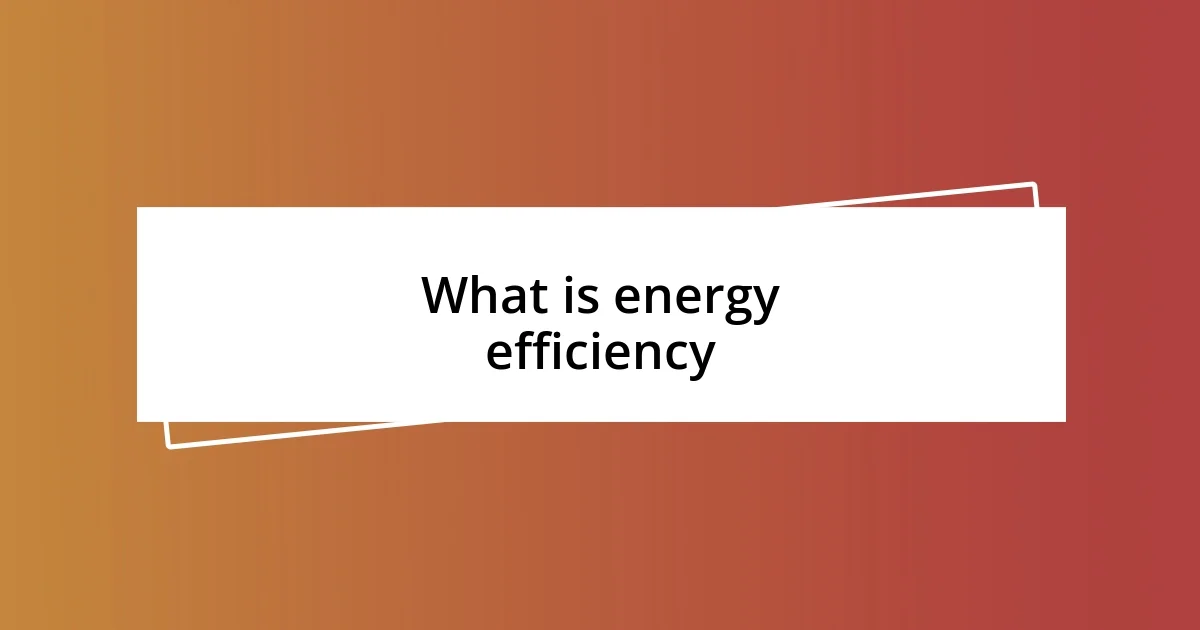Key takeaways:
- Energy efficiency involves using less energy for the same output, leading to financial and environmental benefits.
- Key strategies for saving energy include upgrading to energy-efficient appliances, improving home insulation, and utilizing smart technology.
- Common misconceptions about energy efficiency include the perceived high costs of upgrades and the belief that small efforts have minimal impact.

What is energy efficiency
Energy efficiency refers to the practice of using less energy to perform the same tasks or produce the same outcome. It’s amazing how something as simple as upgrading to LED lighting can drastically reduce energy consumption while still providing the same brightness. Have you ever thought about how often we overlook such straightforward changes in our daily lives?
In my experience, energy-efficient solutions can lead to substantial savings, both financially and environmentally. For instance, I remember when I decided to invest in a high-efficiency washing machine—it not only cut down my water and electricity bills, but it also made me feel like I was contributing positively to the planet. Isn’t it rewarding to know that small decisions in our homes can collectively lead to a significant impact?
When we talk about energy efficiency, we’re really discussing the balance between energy use and productivity. Take the time I swapped out my old refrigerator for an Energy Star-rated model; the difference was striking! The new fridge kept my food fresher for longer, and I felt a sense of pride knowing I was using energy wisely. What small steps could you take in your own life to make a difference?

Importance of energy efficiency
The importance of energy efficiency can’t be overstated. Not only does energy efficiency save money on utility bills, but it also plays a crucial role in reducing our carbon footprint. I remember how amazed I felt when my energy costs dropped significantly after insulating my home. It was not just about the savings; it also gave me peace of mind, knowing I was consuming less energy and doing my part for the environment.
- Lowering energy bills and improving household budgets.
- Enhancing comfort and quality of life with better appliances and setups.
- Reducing greenhouse gas emissions and combating climate change.
- Increasing property value through energy-efficient upgrades.
- Promoting a sustainable lifestyle that can inspire others.
These aspects of energy efficiency resonate deeply with me; every improvement feels like contributing to a greater cause. Each small change can lead to a ripple effect, encouraging friends and family to join in. Have you thought about how your actions could inspire those around you to consider energy efficiency?

Benefits of improving energy efficiency
Improving energy efficiency isn’t just a trend; it’s a transformative journey. I’ve experienced firsthand how updating an aging heating system can enhance comfort levels in winter while treating my wallet kindly. After switching to a high-efficiency unit, my home felt warmer, and I noticed a surprising dip in my energy expenses. Isn’t it fascinating how comfort and savings can coexist so seamlessly?
One significant benefit of embracing energy-efficient practices is the positive environmental impact. I recall attending a community seminar where we discussed the urgency of reducing our carbon footprint. It struck me how collective efforts, like encouraging widespread energy-saving techniques, can significantly lower greenhouse gas emissions. Knowing that my choices contribute to this larger mission fuels my passion to advocate for change in others as well.
Additionally, there’s a long-term financial gain associated with investing in energy-efficient technologies. Take my acquaintance who renovated her home with smart home devices. She saw her property value soar, not only from the aesthetic improvements but because energy-efficient upgrades are increasingly appealing to prospective buyers. The blend of financial prudence and environmental responsibility creates a win-win situation that I strive for in my own home.
| Benefit | Explanation |
|---|---|
| Cost Savings | Lower utility bills due to reduced energy consumption. |
| Enhanced Comfort | Improved home comfort levels with newer, efficient appliances. |
| Environmental Impact | Decreased greenhouse gas emissions, contributing to sustainable living. |
| Increased Property Value | Higher resale value through energy-efficient upgrades. |
| Positive Influence | Inspiring others to adopt similar energy-saving practices. |

Key strategies for energy saving
One effective strategy for saving energy that I can’t recommend enough is incorporating energy-efficient lighting. After I switched out all my old incandescent bulbs for LED lights, I was taken aback by the difference. Not only did my home ambiance feel cozy and inviting, but my electricity bill also reflected a noticeable decrease. Isn’t it amazing how such a simple change can make such a big impact?
Another key strategy is to evaluate and enhance insulation. I remember how shocked I was during a winter home energy audit when I discovered drafts around my windows and doors. Sealing those gaps was a relatively easy project, but the warmth and comfort it brought to my living space transformed my entire winter experience. Have you ever thought about how much energy you might be losing through unnoticed leaks?
Finally, embracing smart technology has been a game changer in my energy-saving journey. The first time I set my thermostat to automatically adjust when I was out, I could hardly believe the difference it made. That intuitive control helped me regulate my energy use while keeping my home comfortable. Can you imagine how much energy we could save if more people embraced these technologies?

Common misconceptions about energy efficiency
Certainly! Here are three paragraphs addressing common misconceptions about energy efficiency:
Many people believe that energy efficiency upgrades are too expensive to be worthwhile. I used to think this way too until I made the leap and installed energy-efficient windows. The initial investment felt hefty, but the subsequent energy savings during the sweltering summer months were monumental. Have you ever considered how long it takes for those savings to balance out the upfront cost? For me, it was quicker than I imagined.
Another misconception is that energy-efficient appliances don’t perform as well as their traditional counterparts. I once hesitated to buy an energy-efficient washing machine because I thought it wouldn’t clean as effectively. However, after trying it out, I was completely blown away by how well it cleaned my clothes—and it used significantly less water and energy too! When have you been pleasantly surprised by something you initially doubted?
Lastly, there’s a common belief that small efforts, like turning off lights when leaving a room, don’t significantly impact energy savings. I used to view my choice to unplug devices as a minor task, but counting up my savings over a month revealed remarkable results! It made me realize that every little action accumulates over time. Isn’t it empowering to know that our daily habits hold the potential for substantial change?

Tools for measuring energy efficiency
One essential tool I’ve personally found invaluable in measuring energy efficiency is the energy monitor. When I installed one in my home, I was surprised to see how much energy different devices consumed in real-time. Seeing those numbers light up on my screen not only made me more conscious of my usage but also motivated me to cut down on unnecessary energy consumption. Have you ever wondered which appliances are silently sucking power?
Another useful tool is the home energy audit, which I recently experienced. A professional came in, checked every corner of my house, and provided a detailed report on where I could improve efficiency. It was like having a personalized guide to energy savings; I learned exactly how to tackle fixes that would otherwise have gone unnoticed. Since then, each recommendation has become a mini-project that brings both savings and satisfaction—it’s hard to match that feeling of making progress!
Lastly, smartphone apps designed for energy tracking have become a part of my daily routine. With just a few taps, I can monitor my home’s energy use and even receive tips tailored to my lifestyle. Tracking my progress over time has been motivating, and I often find myself asking, how can I do better tomorrow? The competitive spirit it instills is a game changer. What tools have you encountered that ignite your passion for energy efficiency?

Future trends in energy efficiency
Have you ever thought about how smart technology is shaping the future of energy efficiency? I recently installed a smart thermostat, and I was stunned by how much control I now have over my energy usage. The ability for it to learn my schedule has not only optimized my heating and cooling but has also saved me money without any extra effort. Isn’t it exciting to think about the potential our devices have to make our lives easier and more efficient?
One of the emerging trends I find particularly fascinating is the increased use of renewable energy sources combined with energy efficiency strategies. I was part of a community solar project, and it transformed my perspective on energy consumption. The combination of solar power and energy-efficient practices not only reduced my bills but also elevated my sense of contribution toward a sustainable future. Have you considered how local renewable initiatives might impact your own energy choices?
Lastly, I’ve noticed that energy efficiency is becoming a focal point in new construction and retrofitting projects. I had the opportunity to tour a newly built passive house, and I was captivated by its ultra-high insulation and smart design choices. It illuminated just how much potential exists in constructing homes that use minimal energy for heating and cooling. Isn’t it encouraging to see that the future of home building is not just about aesthetics, but also about creating sustainable and energy-efficient living spaces?












